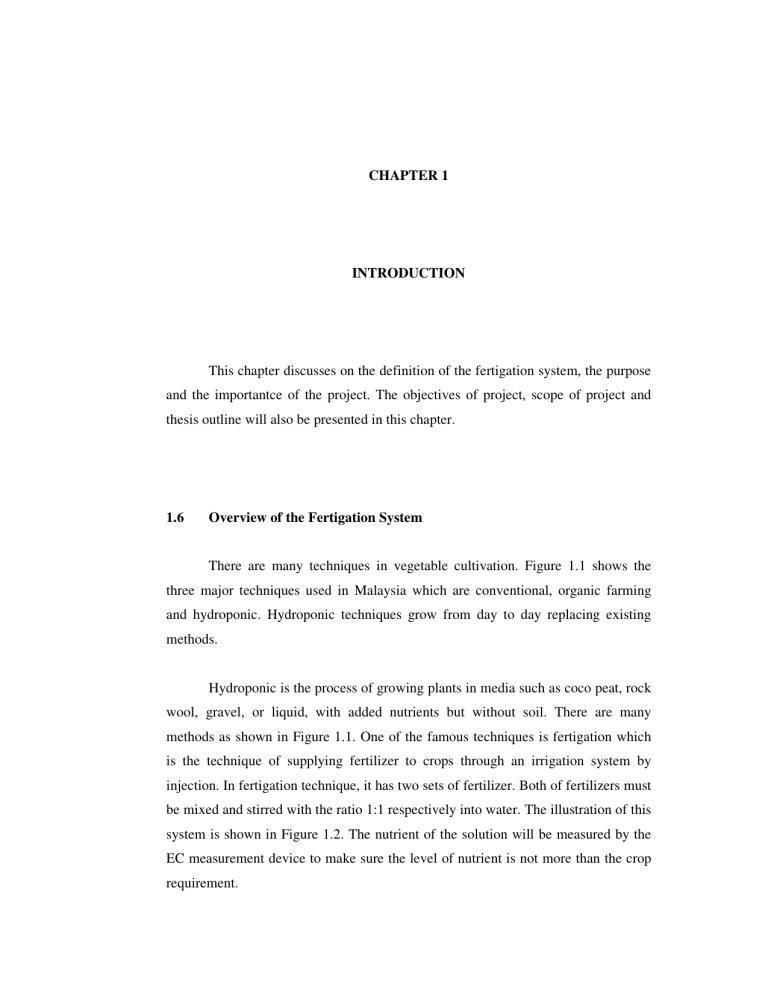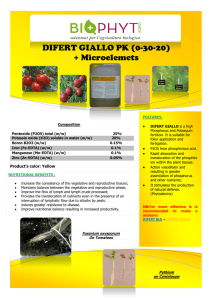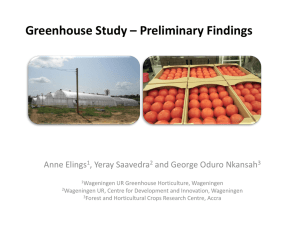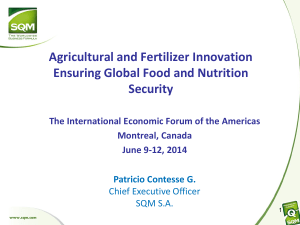CHAPTER 1 INTRODUCTION

CHAPTER 1
INTRODUCTION
This chapter discusses on the definition of the fertigation system, the purpose and the importantce of the project. The objectives of project, scope of project and thesis outline will also be presented in this chapter.
1.6
Overview of the Fertigation System
There are many techniques in vegetable cultivation. Figure 1.1 shows the three major techniques used in Malaysia which are conventional, organic farming and hydroponic. Hydroponic techniques grow from day to day replacing existing methods.
Hydroponic is the process of growing plants in media such as coco peat, rock wool, gravel, or liquid, with added nutrients but without soil. There are many methods as shown in Figure 1.1. One of the famous techniques is fertigation which is the technique of supplying fertilizer to crops through an irrigation system by injection. In fertigation technique, it has two sets of fertilizer. Both of fertilizers must be mixed and stirred with the ratio 1:1 respectively into water. The illustration of this system is shown in Figure 1.2. The nutrient of the solution will be measured by the
EC measurement device to make sure the level of nutrient is not more than the crop requirement.
2
3
The advantages of supplying mineral nutrients to crop roots using fertigation include: i.
Reduced delivery costs (no need to broadcast fertilizers, leading to less soil compaction in the inter-row areas, less fuel usage and lower labor requirements). ii.
iii.
Greater control over where and when nutrients are delivered, leading to the greater fertilizer use efficiency.
More control over crop behavior through targeted application of specific nutrients during particular stages of crop development. iv.
ii.
Potential to reduce fertilizer losses (due to immobilization within or i.
leaching below the root zone) by supplying small amounts constantly.
Disadvantages of supplying mineral nutrients to crop roots using fertigation include:
Greater capital costs associated with the equipment needed to dissolve and inject the fertilizer into the irrigation water.
Higher operating costs associated with using technical grade iii.
fertilizers as opposed to agricultural grade fertilizers.
Chemical reactions between some types of fertilizers when mixed, potentially causing significant equipment blockages.
4
1.7
Objectives of the Project
The aims of this project are to design, provide reliable and maintain a mixing process of fertilizers set A and set B at set point using PID controller. Specifically the objectives of this project are: i. ii.
To study on the process of mixing fertilizers set A and set B in the fertigation system
To establish the relationship between electrical conductivity, salinity of mixture of fertilizer set A and set B and design an EC sensor using carbon probe. iii.
To design and develop a low cost PID controller for the mixing process of fertilizer set A and set B to determine certain level of EC.
1.8
Scope of the Project
This project is divided into two parts, which are:
Part 1: Hardware development
Firstly, literature studies on the concept of automatic fertigation techniques are revised. Microcontroller Arduino Mega 2560 is used to interface with the actuator and sensor. The simple and low cost Electrical Conductivity sensor (EC) will be proposed to measure the EC in the solution tank. The correlation between actual value of EC vs salinity is determined experimentally using conductivity probe.
The data are used as a calibration of the EC sensor.
Part 2: Software Development
This project focused on PID controller design using Ardino-LabVIEW.
Microcontroller type Arduino Mega 2560 is used to interface with the actuator and
5 sensor. A model of fertigation system based on a PC-based will be built to evaluate the performance of PID controller.
1.9
Project Planning
This project was implemented based on the project planning schedule. The project started from Sept 2013 and ended in May 2014. The project planning schedule is presented in Appendix A.
1.10
Thesis Outline
Chapter 1 presents the overview of the automatic fertigation system, the objectives of the project, project schedule and thesis outline.
Chapter 2 covers the literature review on the fertigation technique, the principles of fertigation hardware and software and PID controller system.
Chapter 3 describes in details the development of PC-based PID nutrient mixing process on fertigation system methodology, and also hardware and software development.
Chapter 4 presents the results of the experiments and measurements. All the results will be discussed in details.
Chapter 5 discusses the overall conclusions and suggestions for future work.








